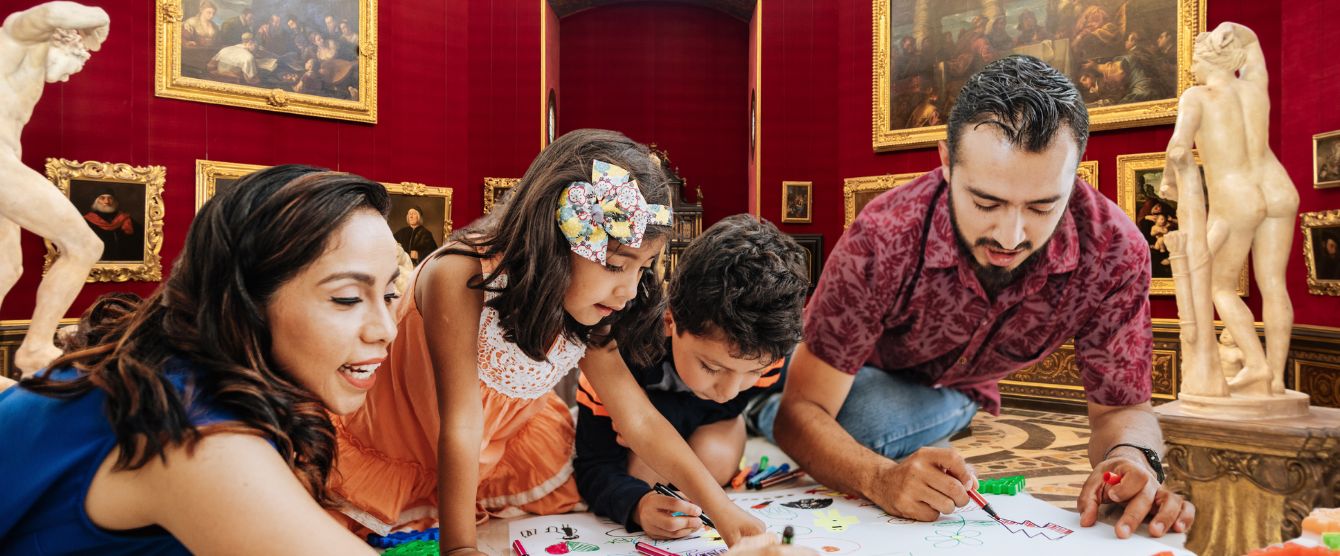Art has the power to inspire, educate, and transform. For homeschool parents looking to enrich their children’s learning experience, incorporating art appreciation into the curriculum can be a rewarding endeavor. Not only does it cultivate creativity, but it also provides a unique lens through which children can explore history, culture, and personal expression. This blog post aims to guide you on how to study art effectively at home, offering practical tips and insights into the works of famous artists. By the end, you’ll have the tools and confidence to bring an engaging art class for kids right into your living room.
The Importance Of Art In Education & Setting Up Your Home Art Studio
Art isn’t just about pretty pictures; it’s a vital part of a well-rounded education. Studies show that exposure to the arts can boost academic achievement, improve social skills, and foster emotional development. For homeschool parents, this means art can be an invaluable tool in your educational toolkit. When children learn how to study art, they develop critical thinking skills, enhance their visual literacy, and gain a deeper understanding of the world around them. Art appreciation also encourages empathy as students explore diverse perspectives and cultures.
Introducing art into your homeschool curriculum can seem daunting, but it doesn’t have to be. Start by integrating art into the subjects you’re already teaching. For example, if you’re studying ancient civilizations, examine their art to gain insights into their culture and beliefs. This interdisciplinary approach not only makes learning more engaging but also helps children see connections between different fields of study. Remember, the goal isn’t to turn your child into the next Picasso but to foster a lifelong appreciation for the arts.
Creating a dedicated space for art activities can make the process more enjoyable and organized. You don’t need a fancy studio; a corner of a room will do. Ensure the space is well-lit and stocked with basic art supplies like paper, pencils, paints, and brushes. Having a designated area for art can help children focus and take their art class for kids seriously. Encourage your child to personalize their space with their artwork, making it a place where creativity can flourish. In addition to physical space, consider setting up a digital space for art exploration. There are numerous online resources, including virtual museum tours, art history websites, and instructional videos, that can enhance your child’s learning experience. These resources can provide valuable context and background information on famous artists and their works, making the study of art more comprehensive and engaging.
Technology can also offer interactive elements, such as quizzes and games, to reinforce what your child has learned. Finally, establish a routine for your art class for kids. Consistency is key to developing any skill, and art is no exception. Set aside regular time each week for art activities and stick to it. Encourage your child to maintain an art journal where they can record their observations, thoughts, and progress. This not only helps track their learning but also allows them to reflect on their artistic journey over time.
Introducing Famous Artists To Young Minds
One of the most exciting aspects of studying art is discovering the lives and works of famous artists. Start with well-known figures like Leonardo da Vinci, Vincent van Gogh, and Frida Kahlo. Share stories about their lives, their struggles, and their triumphs. These narratives can humanize the artists, making their works more relatable and inspiring for young learners. When children see that even great artists faced challenges, it can motivate them to persevere in their own creative endeavors. To make the experience more interactive, recreate some of the artists’ famous works together. This hands-on approach not only reinforces what they’ve learned but also allows them to practice various techniques and styles.
For example, after studying van Gogh, try replicating his iconic “Starry Night” using your own materials. This exercise can help children understand the artist’s unique brushwork and color choices, deepening their appreciation for his work. Another effective method is to compare and contrast different artists and styles. Discuss the differences between Renaissance art and Impressionism, or explore how modern art challenges traditional notions of beauty and form. These discussions can encourage critical thinking and help children develop their own preferences and tastes in art. Remember to ask open-ended questions like, “What do you think the artist was trying to convey?” or “How does this painting make you feel?” to stimulate thoughtful conversation.
Exploring Different Art Mediums
Art isn’t confined to just painting and drawing. Introduce your children to a variety of mediums, including sculpture, photography, and digital art. Each medium offers its own set of challenges and opportunities for creative expression. For example, working with clay can enhance fine motor skills and spatial awareness, while digital art can introduce children to new technologies and software. By exploring different mediums, children can discover their preferences and expand their artistic horizons. Start by gathering basic materials for each medium. For sculpture, you’ll need clay, carving tools, and possibly a kiln to fire finished pieces. Photography requires a camera (even a smartphone will do) and basic editing software. Digital art can be created using tablets or computers to withdraw applications.
Encourage your children to experiment with these materials and see what they enjoy the most. The goal is to expose them to a wide range of artistic possibilities. Incorporate projects that combine multiple mediums. For instance, create a mixed-media collage that includes elements of painting, drawing, and photography. This not only makes the art class for kids more dynamic but also teaches them how different techniques can complement each other to create a cohesive piece. Encourage them to think outside the box and use unconventional materials like fabric, metal, or found objects in their art. This fosters creativity and innovation.
Incorporating Art History & Exploring Cultural Art
Art history provides a rich context for understanding why and how different art movements developed. Introduce your children to key periods and styles in art history, such as the Renaissance, Baroque, Impressionism, and Modernism. Explain how historical events, cultural shifts, and technological advancements influenced the artists of each era. This knowledge can help them see art as a reflection of its time and appreciate the evolution of artistic expression. Use timelines and visual aids to illustrate the progression of art movements. Show them examples of representative works from each period and discuss the distinctive features of each style.
For instance, explain how Impressionist artists like Monet and Degas broke away from the detailed realism of earlier styles to capture the fleeting effects of light and color. Discuss how these changes were received by society at the time and their lasting impact on the art world. Make art history engaging by incorporating storytelling. Share fascinating anecdotes about famous artists and their lives. For example, tell them about how Van Gogh created some of his most famous works during his time in an asylum or how Frida Kahlo used her art to express her pain and resilience. These stories can make historical figures more relatable and inspire your children to explore their creative potential.
Art is a universal language that transcends cultural boundaries. Expose your children to art from different cultures to broaden their understanding and appreciation of the diverse ways people express themselves through art. Explore traditional art forms such as African masks, Japanese woodblock prints, Aboriginal dot painting, and Native American pottery. Discuss the cultural significance and symbolism behind these art forms, and encourage your children to create their interpretations. Organize themed art projects that focus on a particular culture. For example, dedicate a week to studying Chinese calligraphy and painting. Provide materials and instructions for creating traditional ink-wash paintings and discuss the importance of calligraphy in Chinese culture.
Another week, explore the vibrant colors and patterns of Mexican folk art. Create papel picado (paper cut-out) decorations or paint colorful Alebrijes (fantastical creatures) inspired by Oaxacan wood carvings. Use online resources to access virtual tours of museums and cultural sites around the world. Many museums offer interactive exhibits and educational materials that can enhance your child’s learning experience. For example, the British Museum’s website features a “Teaching History with 100 Objects” section that includes artifacts from various cultures and historical periods. These resources can provide valuable context and inspire your child’s curiosity about the world.
Instilling A Lifelong Love Of Art
Art appreciation at home can be a fulfilling and enriching experience for homeschool families. By incorporating art into your curriculum, creating a dedicated space, exploring different mediums, and connecting with the art community, you can instill a lifelong love of art in your children. Remember that the goal is not to create professional artists but to inspire creativity, critical thinking, and a deeper understanding of the world. Start your art appreciation adventure today and watch your child’s creativity soar!





